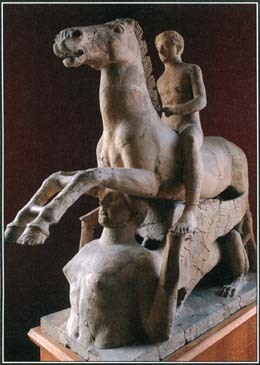Castor and Pollux
In Greek and Roman mythology, Castor and Pollux (known as Polydeuces to the Greeks) were twin brothers who appeared in several prominent myths. The twins were worshiped as gods who helped shipwrecked sailors and who brought favorable winds for those who made sacrifices to them. The Romans considered Castor and Pollux the patron gods of horses and of the Roman social order of mounted knights, called equites.
patron special guardian, protector, or supporter
Myths and Variations. There are many stories about the twins and numerous verions of those stories. According to the Greek poet Homer*f, Castor and Pollux were the sons of Tyndareus and Leda, the king and queen of Sparta*. For this reason, they are sometimes called the Tyndaridae (sons of Tyndareus). Another account identifies the twins as the sons of Leda and Zeus*, from whom they received the name Dioscuri (sons of Zeus). Still another legend says that Castor was the son of Leda and Tyndareus—and therefore a human—while Pollux was the son of Zeus—and

In one of the earliest myths about the twins, Castor and Pollux rescued their sister Helen* after she had been kidnapped by Theseus*, king of Attica. Helen would later gain fame as the person who caused the Trojan Warf. The twins also accompanied Jason* and the Argonauts on their voyage in search of the Golden Fleece. During that expedition, Pollux demonstrated his boxing skills by killing the king of the Bebryces. When a storm arose on the voyage, the Argonaut Orpheus* prayed to the gods and played his harp. The storm immediately ceased, and stars appeared on the heads of the twins. It is because of this myth that Castor and Pollux came to be recognized as the patrons of sailors.
Another story concerns the death of Castor. According to one account, the twins wanted to marry their cousins Phoebe and Hilaria. However, the women were already promised to two other cousins, Idas and Lynceus. Castor and Pollux carried the women away to Sparta, pursued by their male cousins. In the fight that followed, the twins succeeded in killing both Idas and Lynceus, but Castor was fatally wounded.
In another version of this story, the four men conducted a cattle raid together. Idas and Lynceus then tried to cheat Castor and Pollux out of their share of the cattle. The twins decided to take the cattle themselves but were caught as they started to sneak away. A fight broke out in which Castor, Idas, and Lynceus were all killed.
immortality ability to live forever
This story also has several different endings. In one, Castor's spirit went to Hades, the place of the dead, because he was a human. Pollux, who was a god, was so devastated at being separated from his brother that he offered to share his immortality with Castor or to give it up so that he could join his brother in Hades. Taking pity on his son Pollux, Zeus declared that the brothers would take turns dwelling in Hades and with the gods on Mount Olympus. On one day, Castor would be with the gods and Pollux would be in Hades. The next day, the two would change places. In another ending, Castor remained in Hades, but Pollux was allowed to visit him every other day. Most versions of the myth say that Zeus placed the brothers in the heavens as part of the constellation Gemini, the twins. Today the brightest stars in the constellation Gemini are named Castor and Pollux.
* See Nantes and Places at the end of this volume for further information.
The Romans developed a strong cult around Castor and Pollux that traditionally dates back to 484 B . C . A temple to the twins was built in the Roman Forum in 414 B . C . in thanks for their help in defeating the Latins, an old enemy, in the battle of Regillus several years earlier. The images of Castor and Pollux appear on many early Roman coins.
St. Elmo's Fire
St. Elmo's fire is a phenomenon that occurs during certain stormy weather conditions. It appears as a glow on the top of tall pointed objects, such as the masts of ships, and is often accompanied by a cracking noise. When stars appeared on the heads of Castor and Pollux during the voyage of the Argonauts, the twins became the special patrons of sailors. From that time, sailors believed that St. Elmo's fire was actually Castor and Pollux coming to protect them during a storm.
cult group bound together by devotion to a particular person, belief, or god
Literature and Music. Castor and Pollux were featured in the works of many ancient Greek and Roman writers. Besides appearing in Homer's poems, the twins have a role in the play Helen by the Greek playwright Euripides*. They also figure in Pindar's* Nemean Odes and in Ovid's Metamorphoses]. There is even a reference to the twins in the Bible. In the New Testament book Acts of the Apostles, St. Paul is said to sail from Malta aboard a ship bearing the sign of Castor and Pollux. The English poet Edmund Spenser included the twins in his poem Prothalamion. The greatest work by the French composer Jean-Phillipe Rameau, the tragic opera Castor and Pollux, was based on the story of the brothers.
See also Aeneid, the ; Argonauts ; Helen of Troy .